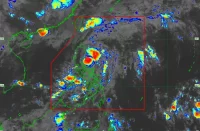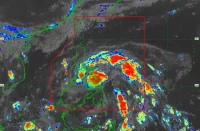Typhoon “Glenda” weakened slightly while traversing the landmass of Luzon on its way to Bataan and Zambales and the West Philippine Sea at mid-morning Wednesday even as 10 areas, including Metro Manila, remain under public storm warning signal No. 3, according to the Philippine Atmospheric, Geophysical and Astronomical Services Administration (PAGASA).
In its 11 a.m. weather advisory, PAGASA said that as of 10 a.m. Wednesday, the eye of the typhoon was located at 35 kilometers southeast of Subic, Zambales or in the vicinity of Bagac, Bataan (14.6°N, 120.4°E).
Glenda’s maximum sustained winds had decreased from 150 kilometers per hour to 140 kph and its gustiness also lessened from 170 kph.
PAGASA said the typhoon also has changed its movement to northwest at 25 kph.
If it does not change its movement and speed, typhoon Glenda is expected to cross Subic, Zambales and exit the Luzon landmass by Wednesday afternoon.
By Thursday morning, it is estimated to be at 450 km west of Laoag City, Ilocos Norte or outside the Philippine Area of Responsibility (PAR).
PAGASA said that the areas still under signal No. 3 (winds of 101-185 kph expected in at least 18 hours) are Zambales, Tarlac, Pampanga, Bataan, Bulacan, Rizal, Cavite, Lubang Island, Pangasinan, and Metro Manila.
The potential impacts of the winds under signal No. 3 are:
• Heavy damage to agriculture
• Some large trees uprooted
• Majority of nipa and cogon houses unroofed or destroyed and considerable damage to structures of light to medium construction
• Moderate to heavy disruption of electrical power and communication services
• Travel by land, sea and air is dangerous
Under signal No. 2 (61-100 kph winds expected in at least 24 hours) are La Union, Benguet, Nueva Vizcaya, Nueva Ecija, Southern Aurora, Quezon, Laguna, Batangas, and northern parts of Oriental Mindoro and Occidental Mindoro.
The potential impacts of the winds under signal No. 2:
• Moderate damage to agriculture
• Rice and corn adversely affected
• Few large trees uprooted
• Large number of nipa and cogon houses partially or totally unroofed
• Some old galvanized iron roofing may roll off
• Travel by all types of sea vessels is risky
• Travel by all types of aircraft is risky
Meanwhile, Signal No. 1 (30-60 kph winds expected in at least 36 hours) is hoisted over Ilocos Sur, Mountain Province, Ifugao, Quirino, the rest of Aurora, Camarines Norte, Marinduque, the rest of Oriental Mindoro and Occidental Mindoro, and Calamian group of islands.
The potential impacts of the winds under signal No. 1:
• Twigs and branches of trees may be broken
• Some banana plants may tilt or land flat on the ground
• Rice plants in flowering stage may suffer significant damage
• Some nipa and cogon houses may be partially unroofed
• Sea travel of small sea crafts and fishing boats is risky
PAGASA said residents in low-lying and mountainous areas under signal #3 #2 & #1 are alerted against possible flashfloods and landslides. Likewise, those living in coastal areas under signal #3 and #2 are alerted against storm surges of up to three meters.
The estimated rainfall amount is from 7.5 to 30.0 mm per hour (moderate to intense) within the 500-km diameter of the typhoon.
The weather agency added that fishing boats and other small sea crafts are advised not to venture out into the seaboards of the Visayas.
Meanwhile, public storm warning signals elsewhere have been lowered.






